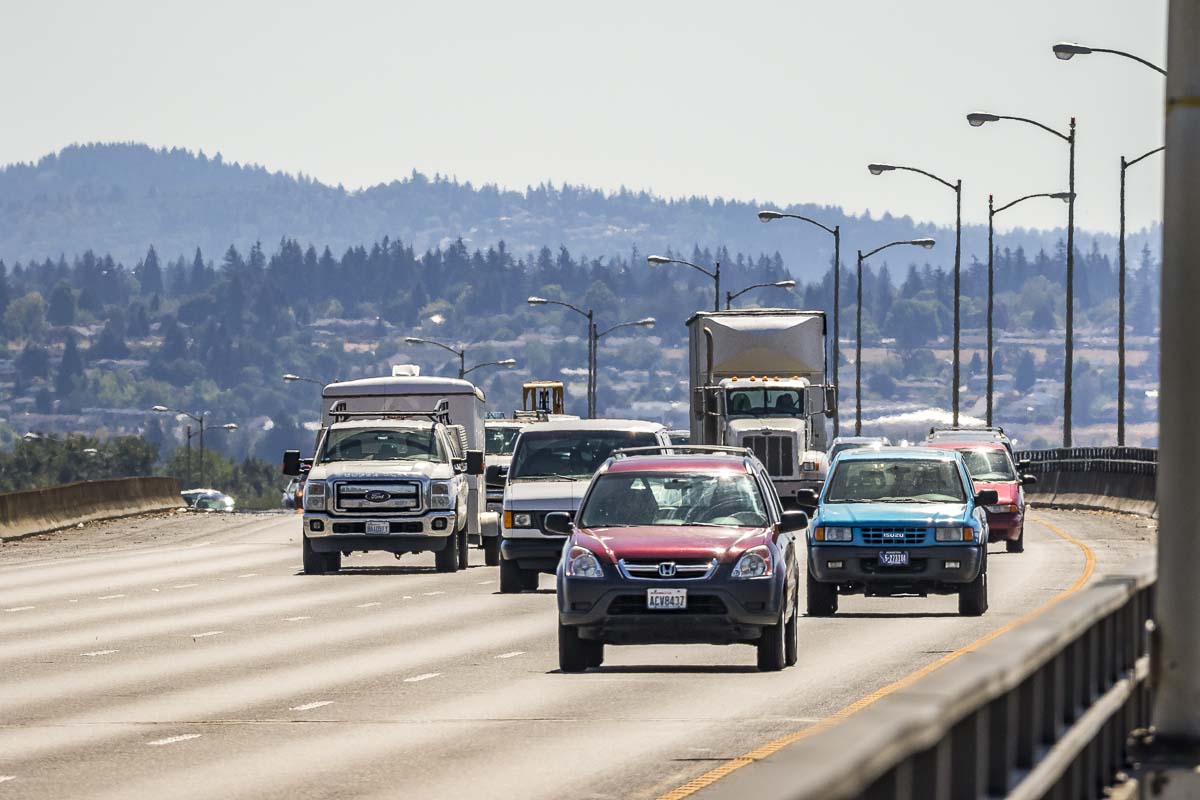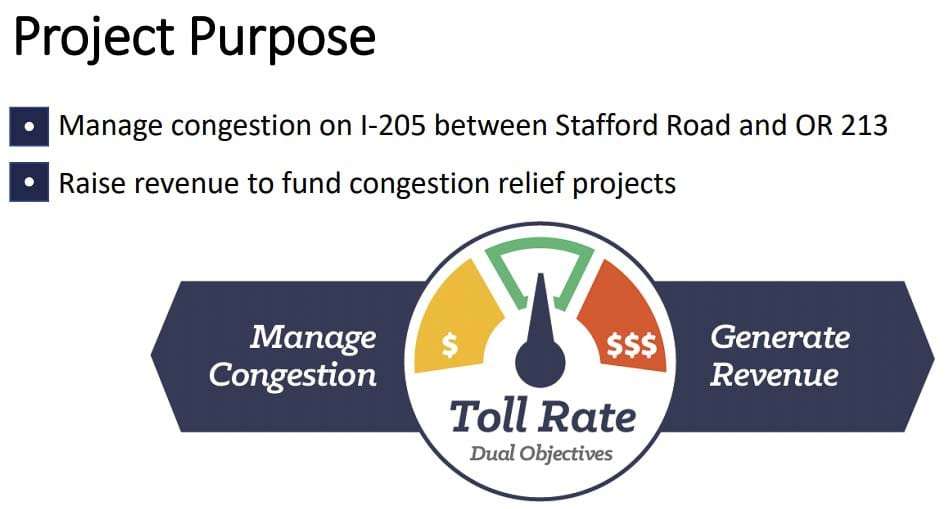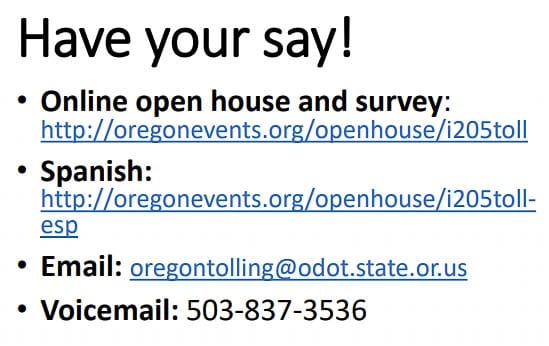Clark County Today continues its examination of Oregon’s plan for tolling on I-5 and I-205 throughout the region
For the past month, Oregon Department of Transportation (ODOT) officials and WSP USA consultants have been briefing elected officials about five alternatives for tolling on Interstate 205.

ODOT has been directed to implement tolling on both I-205 and I-5 by the Oregon Legislature in House Bill 2017. The $5.3 billion transportation package increased the gas tax and car registration fees to pay for transportation projects around the state. It also included language directing ODOT to evaluate and then implement tolling on I-5 and I-205 beginning “at the border’’ with Washington. That would impact the more than 70,000 Clark County residents who commute to Oregon for work.
ODOT has extended the public comment period about the proposed alternatives to Sept. 23. It may be extended further as Oregon state officials respond to ongoing wildfires.
The Southwest Washington Regional Transportation Council (RTC) and the Canby City Council were two of many government agencies recently briefed on the purpose and needs of the I-205 tolling project.

The stated purpose of the tolling is twofold:
• Manage congestion on I-205 between Stafford Road and OR 213
• Raise revenue to fund congestion relief projects through variable-rate tolls
A logical question to many observers would be: Why does ODOT and their consultants propose to “manage” congestion as opposed to “reduce congestion” or “eliminate congestion” in the purpose statement?
Citizens might recall during the battle over the failed Columbia River Crossing (CRC), officials routinely referred to the “Locally Preferred Alternative,” or LPA. The wording was critical, as the end proposal did not significantly reduce traffic congestion — all estimates indicated that the CRC project would offer just a one-minute improvement in the morning, southbound commute.
That history suggests citizens should focus on the wording of the I-205 tolling “purpose and need” statement because how the problem is defined sets the stage for what solution is acceptable. Additionally, the I-205 “purpose and need’’ statement will likely be used for the I-5 “purpose and need,’’ which will more directly impact Southwest Washington drivers.
ODOT identifies the “need” as a 20.1-percent increase in vehicle hours of delay and a 13.4-percent increase in hours of congestion, during the time period 2015 through 2017. ODOT officials add future population growth as well as traffic and freight congestion as part of the problem to be addressed.
ODOT officials indicate funding is needed for congestion relief projects, saying “available funding not keeping pace with need.” ODOT also indicates funds are needed for “I-205 Improvements Stafford Road to OR 213 Project, including Abernethy Bridge.”
Regarding the $5.3 billion in transportation funds raised by Oregon’s HB 2017, citizens need to remember that Oregon has a history of allocating available funds to other projects, such as light rail, transit, bike and pedestrian projects. Prior to the passage of HB 2017, for example, Oregon spent $1.5 billion on the Tillicum Crossing Bridge (which carries no cars) and a new light rail extension into Milwaukie.
On Wednesday, Clark County Today reported about Portland Metro’s $7 billion transportation proposal. In that proposal, the Stop Metro Wage Tax group opposing the proposal claimed that only 3 percent of the funds raised would be spent to reduce traffic congestion.
$7 billion Portland Metro transportation measure at risk

Canby City Council presentation
Will the proposed “solution” solve the problems ODOT identified in the purpose and need statement for the I-205 tolling proposal? How will their proposal “solve” the traffic congestion problems, when ODOT states they simply want to “manage” the congestion while raising money via tolls?
Canby City Council members expressed the concerns of many citizens during the recent briefing they received on the proposal. Canby City Council President Tim Dale criticized the lack of clarity ODOT has presented as to why the agency needs more revenue and what it would be spent on. Councilor Sarah Spoon pointed out that Highway 99E is already a source of never-ending complaints. ODOT officials admit their proposals will increase traffic significantly on Highway 99E due to traffic diversion, as drivers seek to avoid the tolls.
In four minutes of remarks, Dale pushed back hard at the ODOT and the WSP USA presenters. “You have a problem statement and a solution statement. Where are the lanes for I-205?” he asked. “You’re going to make things worse!
“This is not a problem statement or solution statement that we can sell to Canby residents or Oregon City residents or I-205 commuters,” said Dale, a commuter himself. “It’s not clear at all where the benefit is to us.”
Dale added: “it doesn’t take a rocket scientist to know that to reduce congestion on 205, you need more lanes.”
Speaking on behalf of the citizens, he stated: “you’re going to make things worse for me. You’re going to cost me more money to get to my job and back home. You’re not going to reduce congestion; you’re actually going to increase it.”
Dale’s full remarks can be viewed in this four-minute video excerpt from the Canby City Council meeting:
Clark County elected officials comment
Rep. Vicki Kraft, of Washington’s 17th Legislative District, attended the recent RTC Board meeting presentation and was asked what concerns she has on behalf of the Clark County citizens?
“Eventually, the tolling could move farther north on both the I-205 and I-5 and impact our workers,’’ said Kraft, referring to the language in Oregon’s HB 2017 directing tolling at the border with Washington. “I will continue to stand up for Washington commuters and fight to prevent this from happening.”
Kraft then spoke to the broader transportation needs for reducing traffic congestion.
“Our citizens need a third bridge between Washington and Oregon to truly reduce congestion in our region, and they’ve said they want one,’’ Kraft said. “This would reduce travel time to and from work in the Portland metro area more significantly than simply replacing the existing I-5 bridge. It will also help our businesses, and the trucks carrying their goods, get to their destinations more quickly and cost effectively.”
Clark County Councilor Gary Medvigy, a member of the RTC Board, took a broader perspective.
“I have heard nothing about what the toll money is needed for and no proof that congestion tolling has any positive impact on congestion over a region,” Medvigy said. The councilor said he wants additional details including how much is needed, where it will go, and how much tolls will cost to collect (administrative overhead) and more.
“All of the congestion discussion, new lanes, freight mobility, smoothing flow, resiliency of the infrastructure during a natural catastrophic or other emergency — argues to one inevitable discussion,’’ said Medvigy. “The Portland-Vancouver metro area needs an additional corridor. There is no other viable solution.”
Kraft echoed the thoughts of Medvigy.
“A third bridge hasn’t been a serious part of any conversation related to new infrastructure projects in our region over the past few years and it needs to be,’’ Kraft said. “There needs to be more than lip service given to this conversation, it’s time for a third bridge to become a reality.’’
ODOT responds to questions
Don Hamilton, ODOT spokesman provided answers to two questions after the presentations posed by Clark County Today.
First, Hamilton was asked who narrowed the five alternatives down to two? And, can you explain their process?
“The project team developed the initial recommendation to advance two of the five alternatives for further study in the NEPA environmental assessment,’’ Hamilton responded. “The project team is seeking community, stakeholder, and agency feedback on the recommendations.”
Second, Hamilton was asked if “no tolls” was an option or possible outcome? “Yes,’’ he said. “A no-build (no toll) option will be considered in the NEPA environmental assessment.”
ODOT Toll Program Director Lucinda Broussard was asked by a Canby City Council member if there will be tolls in perpetuity and if the tolls will ever go away. Broussard indicated the Oregon Transportation Commission will decide if the tolls will sunset.
In his four-minute remarks, Dale offered understandable skepticism.
“You’re dealing with a community that’s going to look at your solution, which is toll I-205, as yet another example where Clackamas County is going to bear the cost of funds being diverted to Portland causes or causes in other parts of the state; where there’s no direct benefit for Clackamas County when it comes to congestion reduction.”
It’s a dynamic Clark County residents could likely be facing when the tolling issue is expanded to all of I-5 and I-205 in the region.
“The war on drivers and their vehicles in our region needs to stop,’’ said Kraft, who referred to a 2018 Pemco survey that reported 94 percent of people prefer to use their personal vehicles. “If people want to drive their cars, which they clearly do, then as policy makers it is our duty to build the proper infrastructure that will meet that demand. Diverting transportation funds to transit projects does not accomplish this. It’s time we provide our commuters and truck drivers the highways, and ability to travel more easily, that they deserve.”
The ODOT slide presentation about I-205 tolling can be viewed here, or here for the video presentation.
Citizens in the Portland metro area, including Clark County residents, can make input to ODOT either via their website or by leaving a phone message. The deadline for input is Sept. 23, unless ODOT elects to extend if further.





